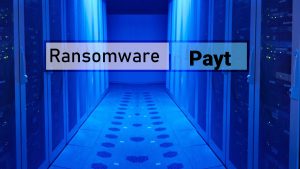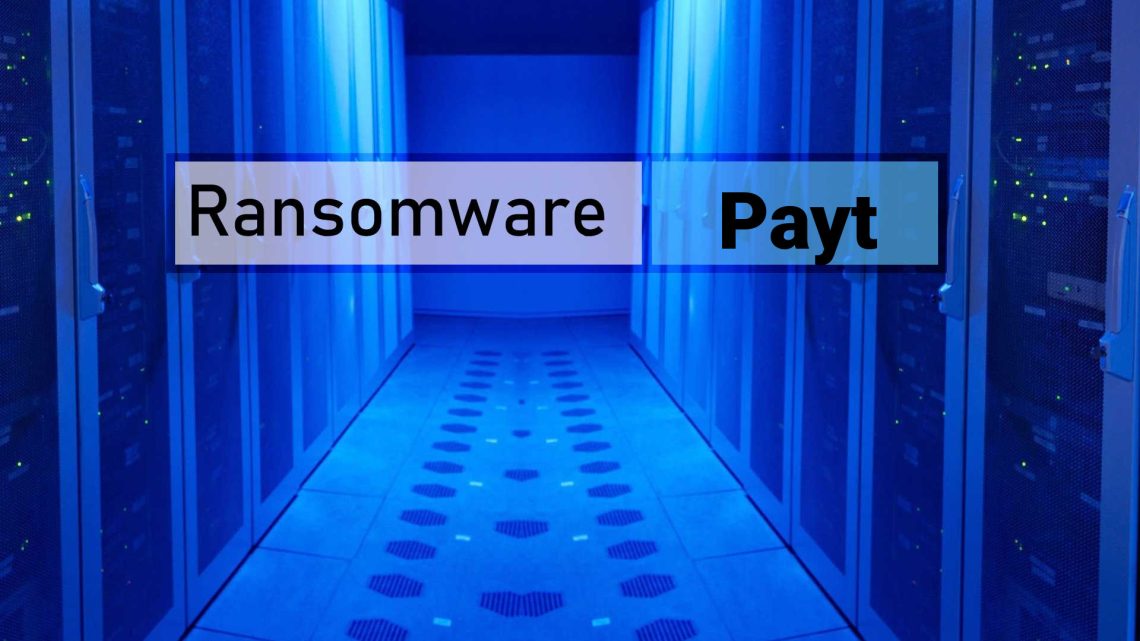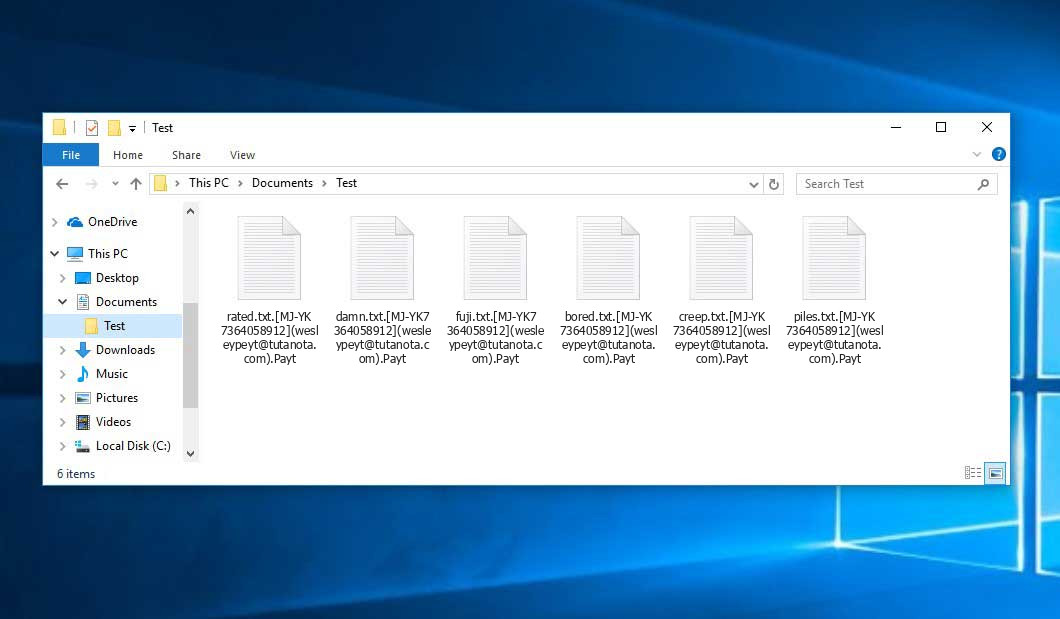The Payt virus belongs under the ransomware type of infection. Malware of this type encrypts all user’s data on the PC (photos, text files, excel sheets, audio files, videos, etc) and appends its specific extension to every file, creating the ReadthisforDecode.txt text files in every directory containing encrypted files.
What is known about the Paytvirus?
☝️ A strictly accurate designation for the Payt would be “a ransomware-type infection”.
The scheme of renaming is this: .Payt. In the course of encryption, a file entitled, for example, “report.docx” will be turned into “report.docx.[MJ-YK7364058912]([email protected]).Payt”.
In each directory that contains the encrypted files, a ReadthisforDecode.txt text file will be created. It is a ransom money note. Therein you can find information on the ways of paying the ransom and some other remarks. The ransom note most probably contains a description of how to purchase the decryption tool from the Payt developers. You can obtain this decryptor after contacting [email protected], [email protected] via email. That is basically the scheme of the felony.
Payt abstract:
| Name | Payt Virus |
| Extension | .Payt |
| Ransomware note | ReadthisforDecode.txt |
| Contact | [email protected], [email protected] |
| Detection | Win32/Injector.ASWI, MSIL/Filecoder.YN, Trojan:MSIL/Autorun.J!ibt |
| Symptoms | Your files (photos, videos, documents) have a .Payt extension and you can’t open them. |
| Fix Tool | See If Your System Has Been Affected by Payt virus |
The ReadthisforDecode.txt document accompanying the Payt malware provides the following dispiriting information:
Your Files Are Has Been Locked Your Files Has Been Encrypted with cryptography Algorithm If You Need Your Files And They are Important to You, Dont be shy Send Me an Email Send Test File + The Key File on Your System (File Exist in C:/ProgramData example : RSAKEY-SE-24r6t523 pr RSAKEY.KEY) to Make Sure Your Files Can be Restored Get Decryption Tool + RSA Key AND Instruction For Decryption Process Attention: 1- Do Not Rename or Modify The Files (You May loose That file) 2- Do Not Try To Use 3rd Party Apps or Recovery Tools ( if You want to do that make an copy from Files and try on them and Waste Your time ) 3-Do not Reinstall Operation System(Windows) You may loose the key File and Loose Your Files Your Case ID :- OUR Email :[email protected] in Case of no answer: [email protected]
In the screenshot below, you can see what a folder with files encrypted by the Payt looks like. Each filename has the “.Payt” extension added to it.
How did my computer get infected with Payt ransomware?
There is a huge number of possible ways of ransomware infiltration.
There are currently three most exploited methods for hackers to have the Payt virus working in your system. These are email spam, Trojan infiltration and peer-to-peer file transfer.
If you access your mailbox and see emails that look just like notifications from utility services companies, postal agencies like FedEx, Internet providers, and whatnot, but whose “from” field is unknown to you, beware of opening those letters. They are most likely to have a malicious item enclosed in them. Thus it is even more dangerous to download any attachments that come with letters like these.
Another option for ransom hunters is a Trojan file model1. A Trojan is a program that gets into your machine disguised as something else. For example, you download an installer for some program you need or an update for some service. However, what is unpacked reveals itself a harmful agent that encodes your data. Since the installation wizard can have any name and any icon, you have to make sure that you can trust the source of the stuff you’re downloading. The optimal way is to use the software companies’ official websites.
As for the peer file transfer protocols like torrent trackers or eMule, the danger is that they are even more trust-based than the rest of the Internet. You can never guess what you download until you get it. So you’d better be using trustworthy resources. Also, it is a good idea to scan the directory containing the downloaded files with the antivirus as soon as the downloading is complete.
How do I get rid of the Payt virus?
It is crucial to note that besides encrypting your files, the Payt virus will most likely install the Azorult Spyware on your computer to get access to credentials to different accounts (including cryptocurrency wallets). That program can derive your logins and passwords from your browser’s auto-filling data.
Sometimes racketeers would decrypt some of your files so you know that they do have the decryption tool. As Payt virus is a relatively new ransomware, anti-malware engineers have not yet found a method to undo its work. Nevertheless, the decoding tools are frequently updated, so the solution may soon be available.
Of course, if the criminals succeed in encrypting someone’s essential files, the desperate person will probably comply with their demands. However, paying to criminals gives no guarantee that you’re getting your files back. It is still dangerous. After obtaining the money, the racketeers may deliver a wrong decryption code to the victim. There were reports about ransomware developers just disappearing after getting the money without even bothering to reply.
The best solution against ransomware is to have aan OS restore point or the copies of your essential files in the cloud storage or at least on an external storage. Of course, that might be not enough. The most crucial thing could be that one you were working upon when it all happened. But at least it is something. It is also advisable to scan your drives with the antivirus program after the system restoration.
There are other ransomware products, besides Payt, that work similarly. Examples of those are Hhwq, Vvwq, Oori, and some others. The two basic differences between them and the Payt are the ransom amount and the method of encryption. The rest is almost identical: documents become encrypted, their extensions changed, ransom notes are found in each directory containing encrypted files.
Some fortunate users were able to decode the arrested files with the help of the free tools provided by anti-malware developers. Sometimes the racketeers mistakenly send the decryption key to the wronged in the ransom readme. Such an extraordinary fail allows the user to restore the files. But of course, one should never expect such a chance. Make no mistake, ransomware is a criminals’ technology to lay their hands on the money of their victims.
How to avert ransomware attack?
Payt ransomware doesn’t have a superpower, neither does any similar malware.
You can defend your system from its injection in several easy steps:
- Never open any emails from unknown mailers with strange addresses, or with content that has likely no connection to something you are expecting (how can you win in a money prize draw without even taking part in it?). In case the email subject is likely something you are expecting, scrutinize all elements of the dubious letter carefully. A hoax email will surely contain a mistake.
- Do not use cracked or unknown software. Trojans are often distributed as an element of cracked software, possibly under the guise of “patch” preventing the license check. Understandably, untrusted programs are difficult to tell from trustworthy ones, because trojans may also have the functionality you need. You can try searching for information about this software product on the anti-malware forums, but the best way is not to use such software.
- And to be sure about the safety of the objects you downloaded, use GridinSoft Anti-Malware. This program will be a perfect armor for your personal computer.
Reasons why I would recommend GridinSoft2
There is no better way to recognize, remove and prevent ransomware than to use an anti-malware software from GridinSoft3.
Download Removal Tool.
You can download GridinSoft Anti-Malware by clicking the button below:
Run the setup file.
When setup file has finished downloading, double-click on the setup-antimalware-fix.exe file to install GridinSoft Anti-Malware on your system.

An User Account Control asking you about to allow GridinSoft Anti-Malware to make changes to your device. So, you should click “Yes” to continue with the installation.

Press “Install” button.

Once installed, Anti-Malware will automatically run.

Wait for the Anti-Malware scan to complete.
GridinSoft Anti-Malware will automatically start scanning your system for Payt infections and other malicious programs. This process can take a 20-30 minutes, so I suggest you periodically check on the status of the scan process.

Click on “Clean Now”.
When the scan has completed, you will see the list of infections that GridinSoft Anti-Malware has detected. To remove them click on the “Clean Now” button in right corner.

FAQ
🤔 Are the “.Payt” files accessible?
Unfortunately, no. You need to decipher the “.Payt” files first. Then you will be able to open them.
🤔 The encrypted files are very important to me. How can I decrypt them quickly?
If the “.Payt” files contain some really important information, then you probably have them backed up. Otherwise, you might try to employ System Restore. The only question is whether you have saved any Restore Points that would be helpful now. The rest of the methods require patience.
🤔 If GridinSoft deletes the Payt malware, will it also delete my files that were encrypted?
Of course not. Unlike the ransomware program itself, the encrypted files do not jeopardize your system.
With the help of GridinSoft Anti-Malware, you can clean your computer off the actual threats. The virus that has attacked your PC is probably still functional and launching checks every so often to encode any new files you might create on your PC after the attack. As it has already been said, the Payt virus comes with the company. It installs backdoors and keyloggers that can take your account passwords by trespass and provide criminals with easy access to your PC in the future.
🤔 What to do if the Payt ransomware has blocked my PC and I can’t get the activation key.
If that happened, you need to have a memory stick with a previously installed Trojan Killer. Use Safe Mode to perform the procedure. You see, the ransomware starts automatically as the system launches and encrypts any new files created or imported into your system. To block this function – use Safe Mode, which allows only the vital applications to run automatically. Consider reading our manual on booting Windows in Safe Mode.
🤔 What could help the situation right now?
Many of the encrypted files might still be at your disposal
- If you sent or received your critical files by email, you could still download them from your online mailbox.
- You might have shared images or videos with your friends or relatives. Simply ask them to send those images back to you.
- If you have initially downloaded any of your files from the Internet, you can try to do it again.
- Your messengers, social media pages, and cloud drives might have all those files as well.
- It might be that you still have the needed files on your old computer, a portable device, cellphone, flash memory, etc.
USEFUL TIP: You can employ data recovery programs4 to retrieve your lost information since ransomware encrypts the copies of your files, deleting the original ones. In the tutorial below, you can see how to use PhotoRec for such a recovery, but remember: you won’t be able to do it before you eradicate the virus with an antivirus program.
Also, you can contact the following official fraud and scam sites to report this attack:
- In the United States: On Guard Online;
- In Canada: Canadian Anti-Fraud Centre;
- In the United Kingdom: Action Fraud;
- In Australia: SCAMwatch;
- In New Zealand: Consumer Affairs Scams;
- In France: Agence nationale de la sécurité des systèmes d’information;
- In Germany: Bundesamt für Sicherheit in der Informationstechnik;
- In Ireland: An Garda Síochána;
To report the attack, you can contact local executive boards. For instance, if you live in USA, you can have a talk with FBI Local field office, IC3 or Secret Service.
I need your help to share this article.
It is your turn to help other people. I have written this article to help people like you. You can use the buttons below to share this on your favorite social media Facebook, Twitter, or Reddit.
Brendan SmithHow to Remove PAYT Ransomware & Recover PC

Name: PAYT Virus
Description: PAYT Virus is a ransomware-type infections. This virus encrypts important personal files (video, photos, documents). The encrypted files can be tracked by a specific .Payt extension. So, you can't use them at all.
Operating System: Windows
Application Category: Virus
User Review
( votes)References
- You can read more on Trojans, their use and types in the Trojan-dedicated section of GridinSoft official website.
- GridinSoft Anti-Malware Review from HowToFix site: https://howtofix.guide/gridinsoft-anti-malware/
- More information about GridinSoft products: https://gridinsoft.com/comparison
- Here’s the list of Best Data Recovery Software Of 2023.



